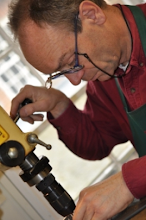I have been drilling a hole of 0.35 mm diameter to re-pivot one of the pivots of the contrate wheel arbor of a miniature carriage clock. The diameter of the arbor is 1 millimetre. It ended up in total failure. It was the first time I was drilling with a tungsten carbide drill. Or rather, tungsten carbide drills in plural. I went through about ten of the box of 50 before I gave up. They all broke in the arbor and I could not get them out anymore, let alone crush them to smithereens in the small hole. The hole was simply too small to do any crushing. Lesson learned: be ultra careful and ditto patient when drilling with tungsten carbide drills if they are that small.
I had to start again with a new arbor and pinion. I was determined to turn the pivots of 0.35 mm and 0.39 mm diameter myself. Again, I failed. I am sure it must be my limited skill in sharpening the tool I use on my watchmaker's lathe. I therefore turned it into an exercise of re-pivoting by drilling 0.45 mm (slightly larger this time) holes at either end of the arbor. I decided to make the pivot holes about 150% longer than what the length of the pivot should be. I made this 150% up as a good gut-feel number. I hope someone will come around and tell me whether this happens to be one of the golden rules of clock making, or, a violation of it. [Addendum: 30 May 2012: Today, an experienced clockmaker kindly explained to me that the generally accepted depth for a hole to repivot is two and a half times the pivot diameter, but that some clockmakers even go for three times.]
Just have the drill touch the arbor and just apply enough pressure to stay connected with it but do not push! Wait for some swarf to become visible then pull the drill slowly back out of what begins to be the pivot hole. Rub away the swarf, wipe your finger gently over the drill to wipe away any swarf sticking to the drill and start again. This way you advance about one tenth of a millimetre every 2 minutes. It does work. You get there in the end. I noticed that I needed complete silence around me because you want to hear the tip of the tungsten carbide drill make contact with the inside of the arbor. Once you hear that slight hissing sound you know that you can apply the minimum amount of pressure you can possibly put on. I was afraid to be disturbed by any unexpected sound around me. The carpenters at the neighbours seemed to have their day off, the children were still in bed, the wife had gone to work. Only the washing machine was spinning in the background which meant I could drill in between its centrifugal spurts.
I noticed that the deeper the hole the longer you will have to wait for swarf to come out. Do not become impatient if you do not see any swarf yet. It is easy, but fatal, to think that you are not applying enough pressure for the drill to do its work. "There is not any swarf, so I must press a bit harder!" Don't! Just sit patiently and wait. Swarf will come. And as soon as you see it, keep that same pressure going for a few more seconds and then pull the drill out again to clean away the swarf from pivot hole and drill and start again.
My turning speed was slow, the same speed at which I would turn steel. Perhaps the whole process can be sped up by increasing the lathe's speed. I did not dare to do this out of fear for breaking the drill which would undoubtedly (Sod's law) park itself in the arbor for good.
Tuesday 26 July 2011
Subscribe to:
Posts (Atom)
